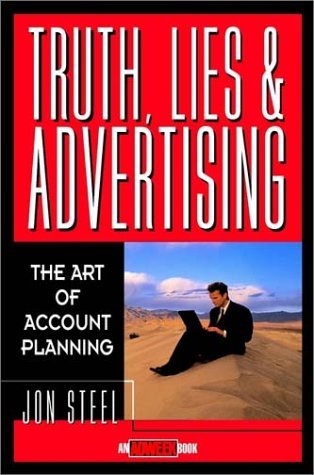 W ramach naszej serii recenzji książek o marketingu niedawno zrecenzowaliśmy książkę Jona Steela „Truth, Lies and Advertising: the Art of Account Planning”. Choć książka skupia się na reklamie, jej treść można realnie zastosować w innych gałęziach usług marketingowych. W szczególności chcieliśmy przeczytać jej perspektywę na temat badań rynku w kampaniach reklamowych.
W ramach naszej serii recenzji książek o marketingu niedawno zrecenzowaliśmy książkę Jona Steela „Truth, Lies and Advertising: the Art of Account Planning”. Choć książka skupia się na reklamie, jej treść można realnie zastosować w innych gałęziach usług marketingowych. W szczególności chcieliśmy przeczytać jej perspektywę na temat badań rynku w kampaniach reklamowych.
Celem Steel jest zaproponowanie nowego modelu reklamy opartego na złożoności ludzi i ich emocji. Model ten obejmuje partnerstwo interesariuszy w kampanii reklamowej:
- client’s business perspective
- agency’s creative perspective
- opinions and prejudices of the people at whom advertising is aimed; In other words, the consumer needs to be probed for insecurities, motivations, habits, and prejudices
In “triangulating” these perspectives, one to pinpoint closer to the truth. Underlying this model is its appreciation for chaos. Steel’s justification is that the sum of the whole is greater than the individual parts. Conversely, if one perspective is allowed to dominate, the quality and effectiveness of an advertising campaign can suffer. Chaos, Steel indicates, can be useful in providing the best work to clients.
- Environment affecting research on advertising
- What sort of mood does it put them in?
- Chance (should be encouraged)
Steel further goes on to draw an unexpected parallel between Quantum Physics and Advertising, in reference to chaos. Ultimately, Steel implies that the chaos and desire for conflicting perspectives in Quantum Physics is similar to his approach of diverse perspectives.
Steel continues to define Advertising according to Jeff Goodby’s definition: getting into one’s mind and changing one’s mind, but not telling one how to think. Along these lines, Steel asserts that Advertising cannot sell something; instead it influences the mind, which can influence purchasing.
So is advertising art or business? Goodby stated that Advertising was the Business of Changing Minds. Hence, it appears that Advertising is a mix of art and commerce, leaning toward commerce. Conceiving Advertising mostly as an art is problematic as it raises the problem of putting the interests of the creative above those of the client’s. Steel implies that Advertisers need to realize that the objective of their clients is to sell products or ideas.
Moreover, is advertising a science or an art? Steel states that advertising is not a science because it neglects the complexity of human emotions. Science assumes that you can breakdown the components and rebuild things according to the machine model by Margaret Wheatley. Excessively scientific data can, according to Steel, focus on the trees and neglect the forest.
Steel writes about the power of the unscientific method. He cites evidence that some of the best brains, including Einstein, Oppenheimer (a physicist), and Watson/Crick, deviated from the scientific method by combining science and art (intuition, fantasy). Steel implies that this occurred because these great thinkers realized that the scientific method could not explain everything.
Contextually, advertising faces several problems in reaching consumers. Advertising is directed at people, and tries to tell them what to do. Messages have been overused. Consequently, people dislike advertising. Steel proposes that the Holy Trinity in Advertising consists of:
- simplicity
- common sense
- creativity
Ideas on Research
Steel asserts that clients assume that those on the outside share their same amount of knowledge, and that it was the role of the planner needs to change this. He indicates that the focus group moderator should have the power to introduce a completely new idea and deviate from the discussion guide. For example, he worked on a project on “Disability Insurance,” which by itself is a word that makes people shudder. Exploratory research was employed to allow the respondent to freely think and speak her thoughts. He found that respondents considered disability insurance as a necessary evil. As a result, the resulting ad campaign focused on the wide picture of the future and the realities that would impact some of the population. The message was that the company had your interests at heart.
Steel also claims that researchers need to look at what is not being said. Citing the example of a project for KPMG Peat Marwick, he had conducted many interviews with high-level executives. All research interviews consisted of the respondent telling the interviewer that what they were saying was all confidential. Hence, he came up with the idea to make a slogan conveying the exciting, stealthy, and confidential nature of what KPMG did.
Ultimately, the book has invigorating examples of creative advertisements. Its easy-to-read writing style is consistent with his overall theories on simplicity and common sense in advertising. Its theories on advertising campaign are helpful in conceptualizing the most effective advertising campaign. Our only displeasure was that its ideas on research did not add much in value from other authors in the genre, such as Clotaire Rapaille author of the “Culture Code.”



